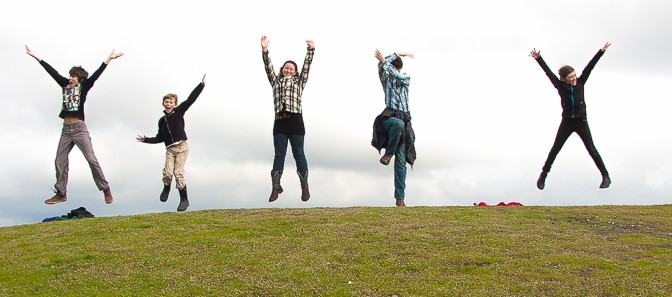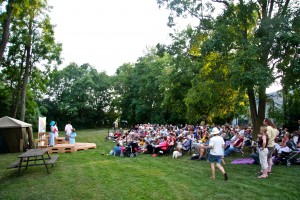Conventionally, neighbourhood parks or parklike open spaces are considered boons conferred on the deprived populations of cities. Let us turn this thought around, and consider city parks deprived places that need the boon of life and appreciation conferred on them. This is more nearly in accord with reality, for people do confer use on parks and make them successes – or else withhold use and doom parks to rejection and failure.
Jane Jacobs – The Death and Life of Great American Cities
While my beloved JJ is writing, in particular, about cities, I think many of her ideas apply equally to small town and rural settings. New Ruralism is as applicable as New Urbanism for creating usable, meaningful public spaces, and associated public life, that suit a variety of purposes for people at varying stages of their life. It is not an ‘and/or’ proposition, but about enrichment for all a place’s inhabitants. Rural towns and villages die out because they lack the economic and social opportunities that cities provide. They decline precisely because they lack vigour and vitality, they age, they become moribund and many lose their context, becoming a mere footnote in history where once they were rooted in the economic and social fabric.
I personally choose life over death.
According to Jacobs, public parks have the opportunity to make a significant contribution to the life of a community or create a resource-sucking dead zone of nothingness. Her principles of creating well-used and consequently, well-loved, community parks not for “mythical uses” set out by city planners or nostalgic public officials or others, but for real citizens with real needs include:
- Placing the parks in the heart of the community, in plain view not tucked out of sight. “Even the same person comes for different reasons at different times; sometimes to sit tiredly, sometimes to play or to watch a game, sometimes to read or work, sometimes to show off, sometimes to fall in love, sometimes to keep an appointment, sometimes to savour the hustle of the city from a retreat, sometimes in the hope of finding acquaintances, sometimes to get closer to a bit of nature, sometimes to keep a child occupied, sometimes simply to see what offers, and almost always to be entertained by the sight of other people.”
- Placing them in mixed-use areas where residents of all ages and needs have different schedules and will use the park at different times of the day and week and for different purposes. “…in real life only diverse surroundings have the practical power of inducing a natural, continuing flow of life and use.”;
- Creating spaces that abet their purposes, either generalized or specialized. This includes design considerations such as “intricacy, centring, sun and enclosure.” What makes spaces interesting and suitable for different people and purposes?;
- Focusing less on “generalized” park spaces, which may serve no one well, and offer “demand goods,” which offer people specific reasons to use to the park and the appropriate spaces to meet those demands. These might include, for example, a ball diamond or cricket pitch, a pool, a communal fire pit, bocce or tennis courts, community food gardens and all manner of special events like concerts and theatre productions (with or without a bandshell), skating parties, specialty food events and other non-generic events with a strong hook to draw people in in a meaningful, interesting and engaging way, leveraging the uniqueness of the place.
Would it take a significant investment of time and money to make better use of the public park spaces we already have? Some uses would. But like so many things in life, I think the greatest impediment is having a vision and a willingness by community members to shed ingrained beliefs about how communities function. So much is right before our eyes, is doable, and often requires little additional effort beyond our existing expenditures of time or money.
Case in point. Just after 7:00pm on Saturday evening, after shooing out fifty bbq guests, I walked down our front path and turned onto the mainstreet that runs the length of our village. I was taken aback by the number of cars parked up and down the road and, as I came closer to the park, the overflow onto every sidestreet in the village. My heart skipped a beat when I heard the actors’ voices and the roar of applause streaming out of the public park. My guests, a mix of locals and friends from farther afield, had taken up their place in lawnchairs along with about two hundred other attendees for an evening of Shakespearean theatre. The play aside, it what a fantastic opportunity to people watch and provided a rare opportunity to walk to a cultural event instead of being car-bound.
I shouldn’t have been surprised by the number of attendees, but I was. Whenever I plan an event I always have those dreadful butterflies and the sickening feeling of “What happens if nobody shows up?” But people did show up on this gorgeous almost bug-free summer evening to see an outdoor performance of Antony and Cleopatra by Ottawa’s “Company of Fools”. No tickets or RSVP were required (it was pass-the-hat offering), which means that you never know what you’re going to get until you get it. Always a leap of faith.
By all accounts, the evening was a stupendous success.The event cost the community nothing. Not one thin dime. My four kids and our young friend Olivia ushered and handed out programs. I was happy to do the event promotion which amounted to perhaps twelve hours of my time plus the request for permission from Parks Canada. The “Company of Fools” brought their own set and lighting, attendees brought their own chairs, and Paul, our local Lockmaster, ensured the grounds were tidy and the lawns cut. The public gardens at the entrance to the park, conceived and installed a few years ago for the celebration of the 175th anniversary of the Rideau Canal, were immaculately groomed, as they always are throughout the season, by local Greening volunteers.
All the parts were already in place. All it really took was a little vision and one phone call. No committees, no complicated coordinated plan. If Torchlight Shakespeare was possible, what else is possible to leverage our park space and enrich our public life?
Public parks and other community gathering spaces are invaluable for many reasons but, I believe, mainly for this: they are public and therefore owned and usable by anyone. It is a brilliant manifestation of democracy that I hope more individuals will creatively embrace.


2 responses to “Parks (By and) For the People”
[…] Parks By (and For) the People […]
[…] Parks By (And For) the People […]